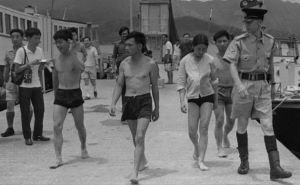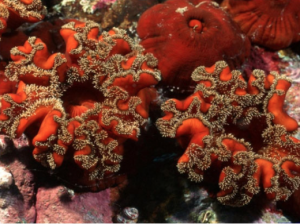Shenzhen’s Dameisha Beach briefly became world famous this month when images of the mountains of litter left by revelers were published in international newspapers. This problem is not new. Last year, one local businessman complained that the beach was so filthy he couldn’t bring his foreign clients there.
Newsworthy as this is, thoughtless individuals throwing litter is far from the biggest threat to Shenzhen’s coastline. Moreover, once-pristine beaches are not the only thing about Shenzhen’s coastline worth preserving.

Dameisha during Dragon Boat Festival, when 362 tons of garbage was discarded on the beach, image via The Daily Mail
A brief look at some of the things that have happened along this coastline involving both human and non-human life shows that it is as evocative and historic as any other. These stories include a 40-day siege by Japanese pirates, mainlanders swimming to Hong Kong to escape Maoist China, the diverse marine life that hindered some of them, and the corporate interests that are destroying this marine life and the coastline itself.
Human stories
Dapeng Fortress in Longgang District, which was built in 1394 to protect the local area from pirates, is one of Shenzhen’s best known historic sites. In 1571, the fortress withstood a more than 40-day siege by Japanese pirates who were armed with ladders.
In the twentieth century, nearby Dapeng Bay was one of several main areas from which mainlanders risked their lives to flee to Hong Kong. Believe it or not, these escapees are among the major reasons why Shenzhen has gone from being a cluster of fishing villages to a metropolis in the space of 30 years.
Mok, 67, told the South China Morning Post last year that, as the son of a former Kuomintang official, he had few prospects in Cultural Revolution-era Guangdong. In 1971, he trained and practiced swimming for months while studying maps and the edibility of particular wild plants while planning his escape. He couldn’t carry maps on his person for fear of arousing suspicion.

Four “freedom swimmers” are led away by police for questioning at Tai Po Kau, Hong Kong in May 1971, image via South China Morning Post
At his first attempt, he and his friends nearly drowned while being captured by border guards. He was taken to various detention centres and beaten before being publicly paraded and sent back to the factory where he worked. The following year he tried again and succeeded. Mok was reluctant to reveal his real name to the paper because he and his family still have business interests in mainland China.
Shenzhen official Wang Shuo wrote in 2011 that an estimated 606,000 people illegally escaped to Hong Kong between 1956 and 1980, more than half of such cases coming in the 1970s. Chen Bingan, author of “The Exodus to Hong Kong” puts the estimate at 2 million, easily outnumbering East Germans who scaled the Berlin Wall or North Koreans who swam across the Yalu River.
The shortest and most popular route to swim was from Shekou to Yuen Long, but this was heavily guarded by People’s Liberation Army soldiers. So high was the casualty rate on this route that it was a paid job during that period to help officials collect and bury the bodies of those shot or drowned on the way.
Dapeng Bay was less well guarded but may have been an even more dangerous place to attempt to swim from. In October 1970, 300 mainlanders sneaked into the colony, 280 of whom had swum from this area. During this period, marine patrol police around Sai Kung regularly found the mutilated bodies of attempted escapees who had been attacked by sharks.
In spite of this, the following year saw a huge surge in “freedom swimmers” according to a contemporary report. In the first eight months of 1971, 2,500 of them were arrested in Hong Kong, a near three-fold increase from the previous year. An estimated 12,500 made it to safety during the same period.
In August 1971, Typhoon Rose caused guards patrolling the border to be diverted to clear up the mess, causing yet another increase. According to “The Great Exodus to Hong Kong,” the peak years for these escapes were 1957, 1962, 1972 and 1979.
These escapees may have been illegal immigrants, but their cheap labor was welcome in Hong Kong. Chen Bingan insists that they played a huge part in Hong Kong achieving its “Pearl of the Orient” economic status, though neither the Communist Party nor the Hong Kong government is keen to commemorate them. Some escapees became Hong Kong residents and the knowledge and skills they acquired were a direct influence on Deng Xiaoping choosing Shenzhen as a Special Economic Zone.
Tan Jialuo, a Cultural Revolution expert formerly of Guangzhou Teachers’ College, thinks this is one of the few examples of ordinary citizens changing Communist Party policy. “It had an important role in the initiation of reform…they effectively helped promote social progress,” Tan said.
Non-human stories
Escapees swimming through Dapeng Bay in those days are said to have had their bodies and limbs scraped by jagged oyster beds. This is a problem they may not have faced in more recent years. Human activity has severely depleted Shenzhen’s marine life and ravaged much of the land along the coast during the Reform and Opening Up period. The famed Shajing oysters, for example, are now gone from the bay.
Chief among this activity is land reclamation, that is the conversion of water surfaces into land for human use. Shenzhen Bay shrank by 25 square kilometers (27% of its total area) between 1997 and 2009. This caused the nearby mangrove forests to be halved from 140 hectares to 70 hectares and reduced the number of migratory birds that spend winter in Shenzhen. The bay could be lost completely in 170 years as sediments grow at a rate of 1.9 cm a year, according to Roger Lin of Shenzhen Daily.
Pollution has also done enormous damage to Shenzhen’s marine life and coastline. In 2011, nearly half of Shenzhen’s coastal waters were found to be severely polluted. Nine sewage pipes were discharging inorganic nitrogen and phosphates into the South China Sea. Professor Xu Hong of Shenzhen University blamed illicit dumping and poor oversight. The situation improved ahead of the Universiade but the bad old days swiftly returned.
The water off eastern Shenzhen where the more popular beaches are located was found to be cleaner and most areas where seafood is farmed were found to be safe, but much marine life and natural beauty has been lost. In the early 1980s, there were vast corals, starfish and shoals of long-gone fish species in Shenzhen’s Meisha area. Due to the city’s “development,” sightseers are now more likely to see tons of floating garbage than coral.

Coral in Dapeng, via doyouhike.net
Plantlife near the coast has also suffered. Chen Cui of Shenzhen’s Green Management Department of Shenzhen Afforestation Committee, who is also known as “The Housekeeper of Shenzhen’s Ancient Trees”, uses great expertise and passion to help protect Shenzhen’s oldest plant life. However, Shenzhen has in recent years failed to preserve the centuries-old trees and pristine villages in Baguang on the northwestern tip of the Dapeng Peninsula.
The struggle to preserve it
In March 2013, an environmental protection group was established to remove 4.5 tons of floating garbage from the ocean off Meisha. It attracted 162 members in a successful first five months before turning its attention to seabed maintenance.
Protecting coral has become a policy in Dapeng. An article published November last year in Southern Metropolis Daily, a paper that has historically been far from a mouthpiece, predicted the recovery of the bay’s corals.
Divers are initiating a comprehensive coral planting campaign. Salinity and water quality are relatively stable and it has a natural barrier so is a good place to grow coral, according to Zhou Xuejia, professor of marine biology.
However, Shenzhen’s coastline is under threat from something more powerful than the cluster of groups and organisations that have taken it upon themselves to protect it – corporate profit. China’s oil and gas behemoth PetroChina announced a plan to reclaim 39.7 hectares of land from the sea off Dapeng Peninsula for the construction of a natural gas depot and wharf.
This will further threaten Shenzhen’s eco-system and decrease the number of places in the city where residents can be by the sea. No less importantly, it will mean Shenzhen loses remnants of its past.
The city needs a power supply and cash needs to be generated, but a balance also needs to be struck if Shenzhen is to develop its own distinct identity. Novelist Italo Calvino once said that a person’s memory must be strong enough to enable them to remain the same person but weak enough to enable them to keep moving forward. The same applies to a city.
 When a moratorium upon fishing was imposed on Shenzhen Bay on May 1 this year, you would’ve thought all fishing in the area would stop because it became illegal. And yet, two months after the fishing ban was imposed, fishing in Shenzhen Bay is still a common occurrence, reports the Shenzhen Evening Report.
When a moratorium upon fishing was imposed on Shenzhen Bay on May 1 this year, you would’ve thought all fishing in the area would stop because it became illegal. And yet, two months after the fishing ban was imposed, fishing in Shenzhen Bay is still a common occurrence, reports the Shenzhen Evening Report.













